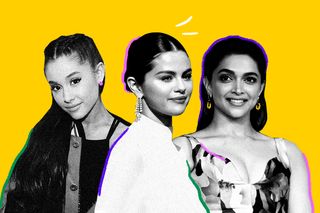
How Beauty Brands Became the New Celebrity Currency
The success of celeb beauty brands relying heavily on the fanbase of the celebrity, rather than the quality of the products themselves.

It’s been around a decade since the world of beauty has found its latest obsession: celebrity-owned beauty brands. Now, Selena Gomez’s Rare Beauty is set to launch in Sephora stores across India tomorrow, prompting much buzz and conversation online. It’s a highly anticipated moment, with Harper’s Bazaar gushing, “The brand is all about tearing down unrealistic standards of perfection and embracing one’s inner beauty. Its core values are inclusivity and self-acceptance. It also champions self-love and empowerment, and addresses mental health issues.” But here’s the million-dollar question: how on earth does a beauty brand — arguably, an instrument to reinforce beauty standards — champion inner beauty?
What makes these brands popular is that they already have a customer base — the celebrity’s fans — that buys into them for their love of the individual star. “You own a piece by following a celebrity on Instagram, Twitter, or TikTok. You have access to them in a different way,” explains Rachel ten Brink, a New York-based venture capitalist. What beauty brands by celebrities bank on is people’s desire to be a part of their idol’s life a bit further — allowing them access to the celebrities’ beauty regime. This is precisely what is behind the success of Rihanna’s Fenty Beauty, Priyanka Chopra’s Anomaly, Millie Bobby Brown’s Florence by Mills, Lady Gaga’s Haus Labs, Deepika Padukone’s 82°E, Ariana Grande’s R.E.M. Beauty, Katrina Kaif’s Kay Beauty, and Drew Barrymore’s Flower Beauty, among scores of other celebrities’ beauty and skincare lines.
But with the success of celebrity beauty brands relying heavily on the fanbase of the celebrity — rather than the quality or efficacy of the products themselves — there’s a misplaced emphasis on brand loyalty that overshadows objective product evaluation and informed decision-making on the part of the consumers. It’s almost manipulative, in a sense.
Not only that, but while the brands may claim to represent the values and aesthetics of the celebrities themselves, there is often a disconnect between the celebrity’s personal journey and the actual development and production of their makeup and skincare lines. It is not uncommon for celebrities to collaborate with established beauty companies and utilize teams of experts to create their products. But despite the number of behind-the-scenes videos we’re inundated with, there’s comparatively little mention of these collaborations.
Related on The Swaddle:
Social Media Is Enabling Fans to Manufacture Celeb ‘Catfights’ Based on Likes, Follows
The information deficit raises questions about the level of genuine involvement of the celebrities with the brands, and whether the products truly do reflect the celebrity’s individuality and beliefs.
However, brands have their ways of making us abandon these lines of thought, one “authentic” celebrity endorsement at a time. Appealing further to the sentiments of fans, thus, is the performance of authenticity that these brands routinely indulge in. A recent example of the allure of such marketing is the endearing video of Deepika Padukone and Shah Rukh Khan getting ready together, as the former coaches the latter on skincare. The viral video featured a third personality, too: 82°E, Padukone’s skincare brand. “Authenticity in marketing is really key, because it’s a precursor of trust. And trust is what gets people to buy into the story and it’s the only thing that influences our purchase behaviors,” Pamela Rutledge, a media studies psychologist, told Vox.
The authenticity, in question, is often a performance to sell products that capitalize on celebrities’ own beauty — one that wasn’t acquired through the use of their own products. In this exercise, the faces of the celebrities themselves become proof of their product’s competence. What we often forget, though, is that even before launching their brands, the celebrities looked just as flawless, bringing the authenticity into question. But our beloved celebrities continue to give their fans and consumers the impression that they look like they do because of their own products. “Celebrities are saying, ‘This is my skincare, this is what I use,’ and ‘No, I don’t get Botox, it’s just my products’,” Stacey Berke, a counselor, told The New York Times, adding how that’s “hard to believe.”
By associating makeup and skincare lines with the glamorous lifestyles of celebrities, the brands sell the idea that one can achieve the beauty and perfection they associate with these celebrities, simply by purchasing their products — leading to feelings of inadequacy and low self-esteem among consumers when that, obviously, doesn’t translate into reality no matter how much of the product they apply on their faces. Unfortunately, then, in the process of employing authenticity as a marketing strategy, celebrity beauty brands become intertwined with the celebrity’s own brand — perpetuating the same unrealistic standards of beauty that propelled them to stardom.
Related on The Swaddle:
Our Obsession With Every Cannes Look Reveals Our Need for Validation From the West
“Currently, the ideal of good skin is very smooth, extremely shiny and wet looking. There is no allowance for changes in tone or texture. It’s very flat and glass-like. It reflects the state of our largely virtual digital lives. We’re expecting our faces to look like a screen,” culture critic Jessica DeFino told NPR.
Further, since our access to celebrities is, after all, limited to screens, what we may overlook easily is the fact that they probably look very different in real life. Yet, we fall into the trap of aspiring for an on-screen face. And in comparing it with our real faces — replete, naturally, with bumps, pores, textures, and spots — we end up subscribing to toxic ideals of beauty. “When movies first came out and we could see actresses on the screen, the lighting wasn’t that great, the camera quality wasn’t that great, and it led to this sort of blurred, ethereal look. And all of a sudden people were like, ‘This is what somebody famous and worthy looks like. I want to look like that, too.’ Every advancement in screens — in cinema, in digital — has had that moment. And we are trying to adapt our real-life human faces to a virtual, hyperreal standard of beauty,” DeFino continues.
The evolution of beauty standards, therefore, has been heavily influenced by the medium through which we perceive celebrities. Now, when they peddle products themselves, it comes attached with a promise they can’t keep; but it sells nevertheless.
While the rise of beauty brands by celebrities may be a testament to the power of their influence, it is crucial not to be swayed by the marketing that is designed to target our adulation. With issues like the commodification of beauty, concerns about authenticity, emphasis on personality over product quality, and the implications of social media marketing, it is pertinent for us, as consumers, to be discerning and conscious of the underlying motivations and messages behind these celebrity-endorsed products.
Devrupa Rakshit is an Associate Editor at The Swaddle. She is a lawyer by education, a poet by accident, a painter by shaukh, and autistic by birth. You can find her on Instagram @devruparakshit.
Related


Salty Recipes For Bitter Characters
